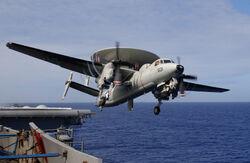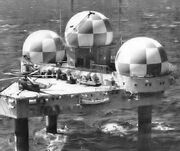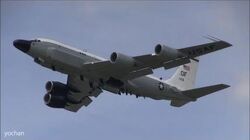
A Boeing RC-135 Cobra Ball. An RC-135 Rivet Joint reconnaissance aircraft moves into position behind a KC-135T/R Stratotanker for an aerial refueling over Southwest Asia March 14, 2006.

An E-2C Hawkeye assigned to the VAW-115 “Liberty Bells” is taking off from USS Kitty Hawk (CV-63) (2004). US Navy Grumman E-2C Hawkeye carrier based AEW&C.
The device it's self
The British, Germans and USA started testing radar systems in the mit to late 1930s. The Nazis were not realy intrested in it, the USA thougt it was usefull and the UK (my home nation) adored it. The term "RADAR" was coined in 1940 by the United States Navy as an acronym for RAdio Detection And Ranging. Radar systems locate and range finds an object by 'shining' (hiting with a beam of) radio waves or microwaves on to it to and the recording the amount of reflected radiation determine the range, altitude, direction, or speed of object such as aircraft, ships, spacecraft, guided missiles, motor vehicles, weather formations, ICBMs and terrain. The radar dish (or antenna) is the item tat transmits the pulses of radio waves or microwaves and is mostly on top of a tower or in a radome on a fixed land instillation like at a airport.
Uses

A picture of an AN/SPS-46(V)9 radar antenna on the USS Theodore Roosevelt aircraft carrier. This is an X-band (8-12 GHz) marine navigational radar similar to types on civilian ships, used to detect other ships in the vicinity. It has a peak power of 7 kW, a range of somewhere around 35 nautical miles. This type of antenna is called a slot antenna and radiates a narrow vertical fan-shaped beam of microwaves, about 15° high and 2.2° wide. A motor in the housing below rotates the bar-shaped antenna to scan the beam around the horizon.
Radar uses include air traffic control, NASA Deep Space Network (DSN), continuous-wave, pulsed, single-polarization, dual-polarization, synthetic aperture radar, and phased arrays. X band radar frequency sub-bands are used in civil, military, and government institutions for weather monitoring, air traffic control, maritime vessel traffic control, defence tracking, vehicle speed detection for law enforcement, en route radar radar astronomy, air-defence systems, antimissile systems; marine radars to locate landmarks and other ships; aircraft anti-collision systems; ocean surveillance systems, outer space surveillance and rendezvous systems; meteorological precipitation monitoring; altimeter and flight control systems, guided missile target locating systems; and ground-penetrating radar for geological observations.
Modern high-tech radar systems are associated with digital signal processing and are capable of extracting useful information from very high noise levels. Several police forces use radar guns to monitor vehicle speeds on the roads. Marine navigation radars often operate with "I-band" frequencies.
Some satellites like GPS use the 1 to 2 GHz range of the radio L band frequencies spectrum.
Airborne radar
The airborne early warning and control (AEW&C) system airborne radar picket system and the Blue Vixen Radar navigation radar are examples of this.
The airborne early warning and control and intelligence gathering radars are different to navigation radar because they can detect and impart identify hostile forces' ships and air craft rather than just warn of near by storms and mountains.
Land based radar
The huge Soviet Duga-3 early warning over-the-horizon radar system was made operational in the Ukraine in 1976. The extremely powerful radio transmissions badly disruption of civilian short-wave broadcasts, hence it's nickname- the "Russian Woodpecker". It was closed as the result of the Chernobyl crisis.
Sea-Based X-Band Radar ships
The concept

A photo of the Texas Tower #3 radar unit.

The Sea-Based X-Band Radar on a covered self propelled oil/gas drilling platform when it is under-way.
It is a development of the 5 experimental 1958-63 Texas Towers radar system, which used the then latest of-shore oil/gas drilling platform technology. 3 of the planned 5 were built. 2 were collapsed a 1 accidentally collapsed.
The Modern Sea-Based X-Band Radar (SBX-1) vessel is a floating, self-propelled, mobile active electronically scanned array early-warning radar station vessel, mounted on a converted 5th generation CS-50 twin-hulled semi-submersible drilling rig, that is designed to operate in high winds and heavy seas as part of the Missile Defence Agency's Ballistic Missile Defence System. The vessel is officially classed by ABS and has the IMO number of 8765412.
Texas Towers specifications
- Part of Air Defense Command (ADC)
- Type Offshore air defense radar
- Condition Out of service and demolished
- Built by United States Air Force
- In use 1958–1963
- Materials Steel
Modern X-Band Radar ships specifications
- Vessel length: 116 meters (381 ft).
- Vessel height: 85 meters (279 ft) from keel to top of radome.
- Vessel draft: approximately 10 meters (33 ft) when in motion or not on station; approximately 30 meters (98 ft) when on station.
- Vessel stability: remains within 10 degrees of horizontal on station (fully passive stabilization).
- Cost: US$900 million.
- Crew: Approximately 75-85 members, mostly civilian contractors.
- Radar range: 2,000 kilometers (1,200 mi).
- Displacement: 50,000 short tons (45,000,000 kg).
Stereotypes

A Chain Home tower in Great Baddow, United Kingdom (2007).

Phased array: Not all radar antennas must rotate to scan the sky. Courtesy of Alaska District, this 90-foot (27m) diameter radar installation monitors the northern sky. Its construction was part of the Clear Radar Upgrade to make all Ballistic Missile Early Warning System radars phased-array rather than mechanical.
They are generality portrayed as dishes and rods that spin, rotate, bounce, rock, lunge, bob, revolve and jolt about.
Some of the older models like the UK's WW2 Chain Home system were more like large radio transmission and reception masts.
Some are hidden in the white or grey radome style buildings informally called 'Golf Balls' or in smaller radomes on aircraft, installations, trucks and ships. It is the smaller type that are the truer definition of what is a radome's domes is.
Modern phased array radars are a immobile roughly pyramidal building with flat sensors stuck to the exterior walls. Radomes can also cover communications and communications interception equipment as well.
An antenna array is a group of multiple active antennas coupled to a common source or load to produce a directive radiation pattern. A slotted wave-guide is a wave-guide that is used as an antenna in microwave radar applications. The Sea-Based X-Band Radar (SBX-1) is a floating, self-propelled, mobile active electronically scanned array early-warning radar station vessel that is designed to operate in high winds and heavy seas.
Jamming and deception methods
- Radar-absorbent materials.
- Stealthy shapes with smooth edges.
- Deceptive jamming to cause a break in a radar lock.
- Cover pulse jamming by firing a short pulse of radar noise at it as the jammer fly over it.
- Pulse jamming as above, but only when the radar is looking at the jammer.
- Base jamming by blocking one particular one in the aria of operations, not a whole load of them.
- Spot jamming by jamming only one frequency.
- Sweep jamming by jamming various one in sequence.
- Barrage jamming by firing at all accsesable radars on all frequency.
- Cover pulse jamming by firing a jamming pulse in response to being targeted (illuminated) by a radar on it's frequency until it backs off.
- Digital radio frequency memory/DRFM jamming/Repeater jamming by issuing a stronger version of the appropriate return signal (radar reflection) at the radar to convince the operator the target is behind it's real location and more distant.
- Decoys, mobile reflective objects and other manoeuvrable flying objects that are intended to deceive a radar operator into believing that they are actually aircraft.
- Corner reflectors that shine most of the radar waves back at the radar and dazzle the radar receiver
- Chaff/window/düppel and other shredded metal devices to reflect multiple strong signals and confuse the radar receiver and/or it's operator.
- Blip enhancement by fly 2 putting sall targets very close to geather to look like 1 big one or 1 big 1nd 1 small targe to hide the smaller one in the bigger one's larger radar reflection.
The Soviet come Russian and Ukrainian WarPac Ground Based ECM Systems are mobile vehicle moved radio and radar jammers. The Kvant SPN-2,3,4 Heart Ache family of mobile jammers are designed to deny surveillance using radars in the 2 to 4 centimetre/ 6.0 to 10.2GHz wavelength bands.
Some of these can be beaten by either turning up the strength of the radar, using it only when it is essential to do so, regularly changing frequency and/or having an intelligent radar crew.
Image gallery
Videos

RC-135 Cobra Ball,Take-off! USAF 45th Reconnaissance Squadron OF Offutt Air Force Base, Nebraska
A USAF Boeing RC-135S Cobra Ball #62-4128 "Reconnaissance aircraft" Take-off.

Sea-Based X-Band Radar (SBX-1) Enters Pearl Harbor
SBX entering Pearl Harbor.

HOW IT WORKS Radar Defense Systems (720p)-0
HOW IT WORKS playlist: https://www.youtube.com/watch?v=4rIHdcwlvlk&list=PLCIsViWU6sLkATemOAURLlP0GK4-dyHRm FOLLOW on: https://www.facebook.com/documentarytube.net https://twitter.com/DocArchive
Also see

Military Radar - A Fascinating Look at Radar Technology-0
From MIT's "Radlab" and the tall radar towers built along England's southern coast to warn of German bombers to U.S. submarines' use of radar to fight the Japanese in the Pacific, see how radar revolutionized the way wars are fought, including moving women to the front lines for the first time. ★★★Watch Most Popular Documentaries Released at http://documentary.center/ ★Let's keep in touch: https://twitter.com/DocumentaryFull ★Facebook: https://www.facebook.com/FullDocumentaries ★Tumblr: http://fulldocumentary.tumblr.com/ ★Google Plus page: http://bit.ly/DocumentaryTower
- Airports
- The tracking tower on Mullach Sgar, St. Kilda
- Saxa Vord radar station
- AI.24 Foxhunter Radar
- Blue Vixen Radar
- Ferranti Blue Fox Radar
- Westinghouse AN/APG-66 fire-control radar
- Phazotron N010 Zhuk-ME radar
- Look-down/shoot-down radar
- RAF Fylingdales
- The DEW Line
- Electromagnetic spectrum
- AN/FPS-108 Cobra Dane radar
- Thule Air Base, Greenland
- AEW&C
- Type 208A monopulse radar
- Boeing RC-135 Cobra Ball
- Cold War radio jamming
- XTAR
- Radome
- RAF Caistor
- RAF Croughton
- RAF Fylingdales
- P-18 radar
- P-12 radar
- Duga-3 early warning over-the-horizon radar system
- Boeing E-3 Sentry (AWACS)
- Beriev A-50
- Omega Tower Trelew
- OMEGA transmitter Chabrier, Réunion
- Omega (navigation system)
- Semi-Automatic Ground Environment (SAGE)
- PAVE Phased Array Warning System (PAVE PAWS)
- Lashup Radar Network
- King Salmon Radar Station
- DRDO AEW&CS
- Gulfstream III
- Beriev A-50 Phalcon
- AN/APG-66(V) radar
- Skrunda-1
- Sonar
- Radome
External links
- http://en.wikipedia.org/wiki/Radar
- http://en.wikipedia.org/wiki/Radar_tower
- http://www.hq.usace.army.mil/cepa/pubs/jul00/story8.htm
- http://en.wikipedia.org/wiki/Radome
- http://en.wikipedia.org/wiki/X_band
- http://en.wikipedia.org/wiki/Radar
- http://www.flightradar24.com/
- http://en.wikipedia.org/wiki/I_band
- http://www.bom.gov.au/australia/radar/
- http://www.accuweather.com/en/us/national/weather-radar
- http://www.intellicast.com/National/Radar/Current.aspx
- http://radaronline.com/
- http://en.wikipedia.org/wiki/Duga-3
- http://en.wikipedia.org/wiki/Electromagnetic_radiation
- http://en.wikipedia.org/wiki/XTAR
- http://en.wikipedia.org/wiki/Radar_jamming_and_deception
- http://www.ausairpower.net/APA-REB-Systems.html
- http://en.wikipedia.org/wiki/Corner_reflector
- http://en.wikipedia.org/wiki/Decoy
- http://en.wikipedia.org/wiki/Boeing_E-3_Sentry
- http://en.wikipedia.org/wiki/Airborne_early_warning_and_control
- http://en.wikipedia.org/wiki/Beriev_A-50
- http://en.wikipedia.org/wiki/Phased_array
- http://en.wikipedia.org/wiki/Slotted_waveguide
- http://en.wikipedia.org/wiki/Sea-based_X-band_Radar
- http://en.wikipedia.org/wiki/Earth_observation_satellites_transmission_frequencies
- http://en.wikipedia.org/wiki/L_band
- http://transition.fcc.gov/Bureaus/International/Orders/1995/da950131.txt
- http://en.wikipedia.org/wiki/Texas_Towers
- http://www.naval-technology.com/projects/sea-based-x-band-radar-1-sbx-1/
- http://www.mda.mil/global/documents/pdf/sbx_booklet.pdf








